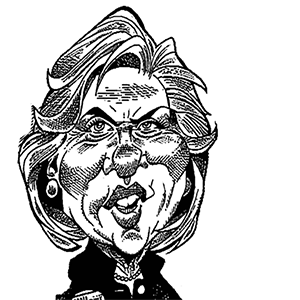Marc Champion: Europe needs to swiftly fulfill its aid pledges to Ukraine
Published in Op Eds
A note to Europe’s leaders: When it comes to sending sufficient aid to help Ukraine end Russia’s invasion, if not now, when?
In October, I visited and wrote about a critical mine at Pokrovsk in eastern Ukraine, which had become the primary focus of Russia’s efforts to maximize the territory it holds amid looming economic pressures from the war at home.
At the time, Russian forces were just 20 kilometers (12 miles) away. Now that’s five kilometers. Suicide drones are hitting civilian cars around the mine and Metinvest BV, the steel company that owns it, last week it had closed and evacuated one of three shafts. There’s little hope of holding out for more than a few days longer at this point, a loss that would cost Ukraine — a nation at war — as much as half of its future steel output.
Pokrovsk is a target for multiple reasons. It’s an important rail and road junction for supplying Ukrainian defensive lines. It is among the last towns still in Ukrainian hands in the Donetsk Oblast, which is among four provinces (in addition to Crimea) that Putin claims to have annexed. Plus, it’s home to the only mine in Ukraine that produces the coking coal for carbonizing steel.
If Europe intends, as its leaders repeatedly say, to support Ukraine in securing a settlement that allows for the country to begin a stable, prosperous and independent future, why the delay in sending aid? That kind of settlement can’t happen so long as Russia believes it can win on the ground.
The Kiel Institute for the World Economy in Germany has been running a project since the start of the Russia’s February 2022 invasion tracking the humanitarian, financial and military aid that Ukraine’s allies have committed and, separately, delivered. The latest update, published earlier this month, found that Europe had committed an impressive €241 billion ($253 billion) worth of support in total, compared with €119 billion for the US, by the end of October.
That’s in one sense promising, given that Europe will soon have to fill a large void should Trump follow through on his campaign promise to reduce American support for Ukraine. He ought to be pleased to hear that Europe is indeed shouldering the majority of the burden – something he’s claimed it doesn’t do.
The Biden administration has been rushing through all of the remaining aid at its disposal before Trump’s inauguration. Earlier this month, German Chancellor Olaf Scholz pledged another €650 million worth of high-end Iris-T and Patriot air defense systems, for delivery by the end of the year.
The disheartening part is the enormous gap between what Europe has pledged and actually delivered, which Kiel estimates at just €125 billion. Some of the difference can be put down to the fact that €52 billion worth of Europe’s commitments came only this fall, as it finally settled on a mechanism to use frozen Russian assets as collateral for loans to Kyiv. But that still leaves Europe €64 billion in arrears.
Kyiv’s exhausted defenders need all the arms and munitions they can get right now. Ukraine desperately needs and wants an end to the war, but for Russia to agree to a genuine peace – rather than just another pause between invasions — President Volodymyr Zelenskyy needs a strong hand at the negotiating table. As it stands, Russia has no incentive to compromise, because it’s winning.
The Ukrainian lines around Pokrovsk are in slow-motion collapse, and the military commander for this part of the front has just been dismissed. Zelenskyy bears part of the blame, having delayed measures to boost conscription for political reasons. He and his generals must also accept responsibility for sending some of their best troops into Russia’s Kursk region. This was always a gamble, because to succeed it required Putin to panic, shifting forces away from his offensive in Ukraine’s Donbas region to counter the threat at home. He did the opposite, upping the tempo of his Donbas offensive, and the bet was lost.
Ukraine’s allies also are at fault as they continue a strategy of “as long as it takes” rather than one of what and when it takes. Whether or not Putin would have resorted to a nuclear strike in Ukraine had the US and other North Atlantic Treaty Organization members provided Ukraine with long-range artillery, tanks and F-16s earlier than they did, when Russia had yet to mobilize or dig in, is a counter-factual. Yet among the many reasons for Ukraine’s current recruitment and retention troubles is the sense that western support — and therefore the weapons and ammunition needed to survive at the front, let alone win — is in increasingly short supply.
This isn’t about sending Kyiv potentially provocative new categories of weapons. Some of what Ukraine needs would have to come from Western stocks and manufacturers, such as the air defense Scholz has promised. But Ukraine’s domestic arms industry can produce the rest. As Zelenskyy’s adviser for strategic affairs Oleksandr Kamyshin told me on my Pokrovsk trip, the defense procurement budget for 2025 is $10 billion, while the production capacity of Ukraine’s combined defense industry will be $30 billion. In other words, Ukraine can now produce most of what it needs to stabilize the lines and equip new battalions — it just lacks the money to buy it.
Denmark is leading a Scandinavian project to square that circle, using Danish funds to contract Ukraine’s arms producers to make weapons that get sent straight from factory to front. The program needs to be supersized, and fast — not to prolong the war, but to end it with a genuine negotiation. To withhold or slow-walk aid now is not pro-peace, it’s pro-invasion.
____
This column does not necessarily reflect the opinion of the editorial board or Bloomberg LP and its owners.
Marc Champion is a Bloomberg Opinion columnist covering Europe, Russia and the Middle East. He was previously Istanbul bureau chief for the Wall Street Journal.
©2024 Bloomberg L.P. Visit bloomberg.com/opinion. Distributed by Tribune Content Agency, LLC.




























































Comments